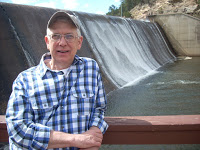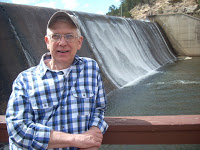One Monday afternoon with a folder of
stories in hand, I made my way to The LGBT Center in the 1100 block on
Broadway, the place with the purple awning that I had visited often to borrow
books from the Terry Mangan Memorial Library. My friend Dianne had looked at
The Center’s website and called me to say they were offering art programs and a
weekly storytellers gathering. She thought I might be interested, and she was
right. For quite a few years I had been attending a writers group, a monthly
gathering of men and women in which I was the only gay, but now I thought I’d
like to read my gay-themed pieces to an LGBT audience to see what response I
would receive. Excited by the prospects I entered the building, climbed the
stairs, registered my presence, and made my way to the library where the group
was to meet.
I knew the storytelling was part of
SAGE, a seniors program, and wondered how I’d compare with other participants.
I was younger except for Jackie who was the group leader. She was quite a bit
younger than I, a graduate social work student at Denver University who had
started the group as part of her internship with SAGE. Jackie’s warm and
friendly personality attracted me, and she was just funky enough and humorous
enough for me to relate to her. Two or three other men attended my first Monday
afternoon with the group. We introduced ourselves to one another and the
storytelling began. Since I’d never attended before, I had no story about the
topic, but I did have a couple of stories about my experiences as an older man
who came to Denver some years earlier to live his life as an openly gay man. Two
participants told stories extemporaneously, sharing interesting events in their
lives. Jackie read her story, something about one of her boyfriends back in New
Jersey. The other participant read his story in a thick Alabama accent.
I knew I had come to the right place. Thus began my tenure with The Center’s
SAGE of the Rockies “Telling Your Story” group, a storytelling relationship
that has endured over three years.
The next Monday afternoon one of the
extemporaneous storytellers surprised us and himself by reading a story.
Somehow the experience of putting his feelings on paper moved him deeply,
reading them aloud nearly devastated him, and hearing them read nearly devastated
the rest of us. What was this group? I suspected our times together might
become more than any of us anticipated.
Over the ensuing weeks—April through
June—we told our stories to one another; sometimes asking questions for
clarification, sometimes responding with our own similar experiences and
feelings, and always appreciating the candor and depth of the sharing. But
Jackie broke into our satisfaction by announcing the end of her internship; she
had received an assignment at another setting for the final months of her
academic program. Michael piped up to say we already had our next leader. We
looked around the room and then a realization hit me. I felt like I was again
in church; I was being volunteered. When the truth of it was clarified, I
agreed only to consider convening the group. The Center would be closed for a
month while the programs moved into the new facility on East Colfax Avenue. I
suggested that on the first Monday afternoon of opening week we come together
with stories on the topic “Beginnings.” In the meantime I would confer with
Ken, the acting SAGE director, about the possibility of leading the group.
I did volunteer to lead the group, an
experience of great importance and meaning for me. Prior to accepting the
responsibility I had gone nearly twelve years without leading any kind of
group. In fact, I had rarely attended any meetings for over a decade. I
reasoned perhaps it was time I re-entered group life and asked the participants
to brainstorm several topics we could use for the next meetings. We did so and
since then have generated so many topics we’ll have to meet weekly for
several years to use them all. The LGBT makeup of the group has presented no
particular challenges because of the personalities of group members and their
dedication to building community that features a broad spectrum of human
experience. But the most important thing I discovered in assuming this
leadership was that the group barely required any leadership, barely needed it.
It’s the easiest group I ever led, and I had led many, many of them in a church
career that lasted thirty years. Also, I never before led a group with such a
high average IQ or so much creativity and talent, both raw and trained. And
still after many months I never can imagine what to expect each week. Such fun,
such humanity, such diversity, such community. It all began for me one Monday
afternoon.
© Denver,
2013
About the Author
Phillip Hoyle
lives in Denver and spends his time writing, painting, and socializing. In
general he keeps busy with groups of writers and artists. Following thirty-two
years in church work and fifteen in a therapeutic massage practice, he now
focuses on creating beauty. He volunteers at The Center leading the SAGE
program “Telling Your Story.”
He also blogs
at artandmorebyphilhoyle.blogspot.com


